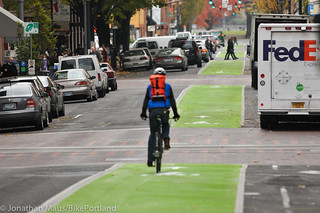
improvements to downtown Portland.
(Photo © J. Maus/BikePortland)
As I’ve hinted at twice since January, the Bureau of Transportation has been working on a grant application that, when funded, will significantly improve downtown bicycle access. Today, they’ve finally shared more information about how the effort is shaping up.
PBOT released a memo today (PDF) with their nominations of eight projects to be funded through two different sources of Metro-administered funds. One of the projects, dubbed Central City Multimodal Safety Improvements, would pump $6 million into planning and implementation of better bikeways. The reason it’s being called “multimodal” illustrates an evolution in Portland bike planning. According to PBOT’s Active Transportation Division Manager Dan Bower, along with developing high-quality bikeways, the project will take a holistic look at the system to see how the bike access improvements might happen alongside improved freight and transit access.
Bower makes it clear that the core of the $6 million project is improved bike access; but they are coming into the project with “eyes wide open” and looking at things “with a multimodal perspective.” This means that the project will likely include improvements for freight and parking access, as well as transit improvements. Bower and PBOT staff have had meetings and/or discussions about this project with the Portland Business Alliance, Mayor Charlie Hales, and the Portland Freight Committee and others.
Bower says he’s using this project to start a larger conversation that he said, “Needs to occur about the bike network downtown, especially at bridgeheads and other portals. We need to make sure we have a connected network.” Bower reports positive meetings and says that the PBA and Mayor Hales support this project.
For the PBA, this is likely a step that shows they can no longer ignore the need to accomodate the major increase in bicycling trips downtown. Their own survey shows that 11% of people who work at their member businesses downtown get to work by bike. PBOT says their numbers show about 30,000 bike trips in and out of downtown each day. With that amount of people riding, it becomes economically smart to make sure they have safe and efficient access to workplaces and businesses.
“We’re not going into this with lines on a map. We’re saying, ‘We need a north/south connection through downtown. Let’s look at which streets make sense.'”
— Dan Bower, PBOT Active Transportation division manager
Bower says PBOT has learned lessons from the past and they are not coming into this project with specific streets in mind. Instead, they will “frontload” money from this grant to kick off an “intensive” planning effort. That planning effort will develop a downtown bikeway network implementation plan. “The Bike Plan for 2030,” said Bower “Has so many priorities that it’s not helpful in identifying tradeoffs.”
In other words, the Bike Plan shows almost every downtown streets as a “bike street”. That’s done more out of fear (that bikes won’t get access at all) than for real planning purposes and it isn’t feasible from the PBA’s perspective or to freight interests. Bower says the new thinking is to approach the bike network similar to how we plan our transit lines (think of the Transit Mall on 5th and 6th). Here’s more from Bower:
“What the PBA and others are interested in is taking a multimodal look at portals and looking at the network overall and saying, ‘This street is a bike street, so this other street might be best for transit or freight.’ [With part of these grant dollars] we’re trying to fund that conversation and come out with some real projects. We’re not going into this with lines on a map. We’re saying, ‘We need a north/south connection through downtown. Let’s look at which streets make sense.'”
Approaching “bike projects” from a more multimodal perspective instead of pushing them through as bike-only, has become an established trend for PBOT. Consider who they successfully massaged freight and business concerns on the NE 12th Avenue overcrossing project. Also look to the N. Williams project, which started as bike-focused, but morphed into a host of safety improvements for people walking, driving, and so on.
Even though this approach means there will be trade-offs (not every street will be excellent for biking on), Bower sees this as a positive step for bicycling overall. “We need to treat bikes with the same seriousness we treat transit and light rail. It’s time for interested parties to take a serious look at how we’re accommodating bikes downtown; and by virtue of that, there will be tradeoffs.”
Also in the grant application is $500,000 that would go to Portland Parks & Recreation for planning and project development of the South Waterfront Greenway, a major project already in process. These funds would go toward ensuring the best outcome for the trail component of that project.
With $1 million of the grant going to planning and project development, that would leave $5 million for actual implementation.
This grant application is part of $22.2 million in available funds through Metro’s 2016-2018 Regional Flexible Funds Allocation, which is part of their Metropolitan Transportation Improvement Program (MTIP). Bower says he expects to receive about $10.2 million in funding for “Active Transportation” projects and $3.7 million for “Green Economy/Freight” projects as per Metro policy. Another $8.26 million is available through what Metro calls the “Regional Economic Opportunity Fund.”
Stay tuned for March 15th, when summaries of all the projects on PBOT’s list will be available.

